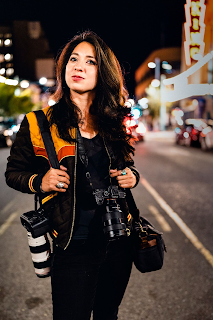Gabriela Campos, born and raised in Sante Fe, New Mexico, began cultivating her photography skills in high school. Seduced by the magic of the dark room film process, Campos slowly (and intentionally) transformed a creative outlet into her lifeblood. Her camera is now a vehicle for telling powerful visual stories, building community, connecting with strangers and showcasing the people and stunning natural beauty of her home state. As a freelance photographer, her incredible work has been featured in several noteworthy publications, including The Guardian, High Country News, Al Jazeera, VICE, The Daily Beast and various local publications. She’s also exhibited in Washington, D.C. alongside fellow photographer Nathaniel Tetsuro Poalinelli.
I connected with Campos to explore the genesis of her career, her creative vision and the importance of being a homegrown creative.
When did you know you wanted to be a photographer?
Gabriela Campos: I first fell in love my senior year of high school. I switched to a new high school and they had this program where you could take photography classes at the community college. I was always interested in [photography] because my dad used to be into [photography]. I took black and white number one, got my dad's old Pentax camera and I experienced the beauty and magic of the dark room — where you just watch something come out of darkness. From that first class, I was hooked.
Why is it important to tell New Mexican stories?
Gabriela Campos: Some people are always seeking to go outside of themselves, and they don't see the potential of their home. There are so many culturally significant things in New Mexico. I'm going through a phase where New Mexico is very much a muse. I am so inspired by the people, the places, the textures, the landscape. It's important to tell the stories that you feel passionately about.
How do you build trust when you go into a new space?
Gabriela Campos: There are two different ways that I approach it. For [The Santa Fe New Mexican] newspaper, I have to be thrown into new situations every single day and feel I can create that sort of intimacy. I show up and I'm interested, and I'm curious. I like to ask people questions. I feel genuine interest goes a long way. Because, it's not often that people get to show off their worlds. Sometimes it's about talking to people. Sometimes I go on assignment and I take photos for the first five minutes, but then people just want to sit down and tell me their story, what's really going on in their lives and the worst of their worlds.
Have you learned a lot from other creatives?
Gabriela Campos: I learn a lot from watching other photographers work. I've been in situations where there's five [or] six photographers and we're all covering the same event. Everybody approaches it a little differently. It's fun to see if people are throwing themselves directly in there, if they're standing far back in the corner trying to get environmental things or if they're trying to get close. I try to remind myself to touch on all the things. Sometimes, I have to say, “step back, show a little bit more, there's more to the story than just people.”
Why is natural lighting your preferred environment?
Gabriela Campos: When you step into somebody's world, you don't often have the luxury of being able to orchestrate all the details. It's about working with what you have, because then you're never reliant on having a flash or a strobe; you're equipped to do what you need to do anywhere if you just train your eye to seek out that natural light. There's nothing more beautiful, [when] it hits in that perfect way.
What’s better, color or black and white?
Gabriela Campos: Sometimes colors can be a little bit distracting. Certain colors, like reds and yellows, are really flashing and people are drawn to them. But maybe you're drawn to it for the wrong reasons. Maybe what I like about the frame is the expression of the person, the shapes, the lines or the way the light hits something. There is definitely a place for colors, because sometimes I'm really attracted to the vibrancy of something.
Could you ever imagine sitting behind a desk?
Gabriela Campos: No, I always wanted to be interacting with people and entering people's worlds; photography is the most absolute, ideal situation for that. Every day I get to be something different. Some days, I'm a firefighter. Some days, I'm a doctor. Sometimes, I drive an Impala around. It lets me see life from [different] perspectives.










